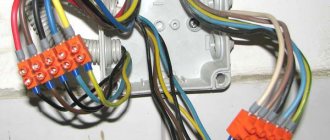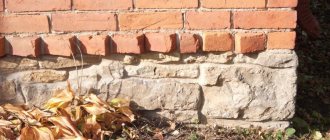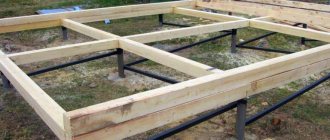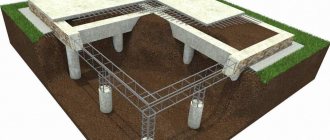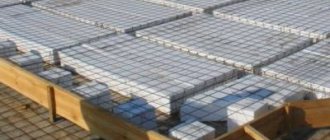The house is growing in width
Increasing the usable space in a private property by adding new premises standing on its own foundation begins with solving the problem of how to connect the foundation to the house so as not to harm both structures. The construction of additional structures usually begins after several seasonal cycles, during which financial resources have been accumulated, a desire has appeared for a new round of site development, and the standing buildings have begun to shrink normally in the ground. Building codes provide the answer to how to connect two foundations to each other, taking into account mutual influence.
Construction of houses
More than half of the owners of country houses sooner or later face the need to expand the area of their home. Naturally, this is easiest to do at the design stage of the building, but at this time, as always, the limited construction budget does not allow for a larger area. What should you do if you have received a residential building and want to build an extension to it? It is recommended to start with the most important stage - connecting a new foundation for an extension to the old one. Let's figure out what kind of foundation to pour for an extension, and how to properly combine the base of the house and the foundation of the attached module.
Content:
The need to join two foundations
Home owners often have a need to increase their living space. A convenient and practical option for expanding real estate is to add block modules, such as a veranda. Such premises are open, so time can be spent here only during the warm season.
Before constructing the module, it is necessary to take into account that an extension to the house is possible only if a list of conditions is met: obtaining the appropriate permits for the construction of new structures, maintaining all permissible distances to neighboring houses and plots, ensuring independent settlement of all elements of the house relative to each other.
Like any construction process, the construction of a veranda should begin with the development of a project. This module near the house must be positioned in such a way that you can get from it into the main room, so it is customary to build a veranda at the end of the house or near the main entrance.
Despite the simplicity of the design, the extension must be completed efficiently and competently, and one of the first problems that arises with this is the installation of a foundation for the building. The best solution when constructing a foundation for an extension next to a house is considered to be combining foundations. Otherwise, cracks may appear in the walls, subsidence of the floor and other troubles may begin.
Features of connecting the old and new foundation
To understand how to properly build a foundation for an extension, you should find out how the foundation under the house is made and what it is like. If the foundation is strip, then you need to know its width; if it is columnar, then the overall dimensions of the pillars, as well as its depth. Experts strongly advise against building a foundation for the extension, which is distinguishable from the foundation of the house. Thus, if your house is located on a monolithic reinforced concrete strip, it is better not to save money and not build a columnar base for the extension.
The bottom line is that different types of foundations interact with soils differently, and accordingly, their shrinkage is different. Therefore, in order not to want to take risks, it is better to bet on the same grounds. The depth of the foundation of the extension must match the depth of the foundation for the house - this avoids distortions. Measuring the depth is quite simple. To measure the width, take a metal rod and bend it at a right angle.
After this, hold the bent part horizontally in your hand and thread it under the foundation. Turn it so that the hook hooks on the opposite side. Next, make a mark on the rod and remove it. You can use the serif to measure the width of the base. In addition, the foundation for the block module must be connected to the existing one, because otherwise the new walls will move away from the old building after some time. And this provokes the formation of cracks and distortions.
An important point that you need to pay attention to if you are going to connect the foundations together is that in the spring there will be a decrease in the bearing capacity of the soil. As a result, its humidity increases. A building built on a new foundation will experience additional shrinkage in the spring.
Considering the fact that old and new buildings may have a significant difference in weight, it is worth understanding that subsidence of the foundations will occur unevenly. Therefore, to connect the foundations between them, you should wait one season before work and provide for a technological gap. Such a gap, as a rule, is a gap that has a size of approximately 20 - 40 centimeters, in which pieces of reinforcing bars are placed that protrude from the foundations.
To expand the foundation, ordinary concrete mortar or reinforced concrete is used. In order for the old and new parts of the foundation to be firmly connected to each other and form a monolithic structure, before pouring the new foundation with concrete, it is necessary to strengthen the foundations: weld the reinforcement of these parts of the foundation or drill reinforcing bars into the old foundation.
Methods for connecting two foundations
The connection of two foundations can be carried out based on one of two solutions: constructing the foundation of the extension separately or rigidly combining it with the foundation of a residential building. When choosing a specific solution, it is recommended to take into account the severity of the attached module and the quality indicators of the soil on the site. If it is uniform, and the built house has not undergone significant shrinkage over time, you can combine the foundation of the building and the base of the extension into a single structure. Otherwise, you should think about building a separate foundation, which will be in contact with the base of the house through an expansion joint.
Rigid connection between the base of the house and the extension
When building a house with your own hands, the most difficult thing is to make a full-fledged rigid connection to create a single residential building-extension structure. As a rule, such a solution is relevant for a situation where the site has slightly heaving or non-heaving soil (when the settlement of the new foundation can be predicted), as well as in the case where it is planned to build a two- or more-story extension with a house under one roof. After the work is completed, a single design will be obtained.
The “tape-to-tape” connection between two strip foundations with your own hands is carried out in this way:
- First you need to dig out the foundation to the depth of the foundation of a residential building; the length of the trench should be about 1.5-2 meters. You should not dig up the entire side, but only part of it, while creating a sand cushion.
- Drill holes in the base of the house that have a diameter equal to the diameter of the reinforcement. For the middle part of the strip, a hole is drilled to a depth of ¾ of the width of the strip foundation in a checkerboard pattern and for the corner parts - to 0.5 meters.
- In the holes that are drilled ¾ of the width of the tape, you need to drive reinforcement with a longitudinal slot into which a wedging insert, for example, made of wood, is inserted. Drive 14 mm reinforcement with a periodic profile into the holes made half a meter long.
- Next, they are engaged in the formation of the frame of the future foundation, using the outlets of driven reinforcement as elements of the new foundation. To join the next parts of the base, releases are made that are 30-40 centimeters long, which are subsequently welded.
A rigid connection for an open contour is formed in a similar way, only the reinforcement is driven in slightly differently and more of it is used per unit area at the points of contact of the two bases.
Rigid docking methods
There are three main methods for rigidly joining the base of an extension to the foundation of a house:
For joining to a strip foundation, the so-called “tape-to-tape” method is used. Pairing using this method occurs in several stages:
- First you need to dig a trench about 2 meters long along the base of the existing house. You should not open the entire foundation at once, this can lead to cracks along the walls of the house;
- Every half a meter in the foundation, holes are drilled in a checkerboard pattern for reinforcement with a depth of about three quarters of the thickness of the base and a diameter equal to the thickness of the reinforcement;
- reinforcement with specially prepared longitudinal slots is driven into all holes, except the outer ones. It is necessary to drive wooden wedges through these slots so that the reinforcement is held tightly in the concrete.
Reinforcement with a periodic profile is driven into the outer holes. For better driving, it would be correct to shape the edges of the reinforcement into a cone using a grinder. The optimal diameter of the selected material is 14-16 mm.
Scheme of a combined foundation for an extension.
At the final stage, all pieces of reinforcement are tied into a single frame, along the edges of which it is necessary to make an extension of 30-40 centimeters for tying into the main foundation of the extension to the house. The reinforcement frames are welded together.
If the foundation is not closed, then the reinforcement is driven into the base of the house one and a half times more often.
The following method is suitable for houses built from gas silicate.
As a rule, when constructing such structures, builders leave slabs extending from the basement of the house by about 30 cm. This will allow the ends of the reinforcement in the slab to be exposed and joined to the slab foundation of the extension. This method is called "slab-slab".
Most often, it is customary to make a foundation for an extension to a house with the formation of an expansion joint or a separate foundation. When choosing this option, the base of the extension must be poured in close proximity to the foundation of the house.
Under the entire perimeter of the extension it is necessary to make a major tape (grillage). The intermediate space between the bases must be properly separated from each other with waterproofing and thermal insulation materials so that during shrinkage the old foundation is not subject to mechanical damage from the extension.
As waterproofing, you can use roofing felt as the cheapest of all possible options. To pour the foundation for an extension to a house correctly, you need to be guided by the same rules and regulations as when building a regular house.
Saving money when choosing materials to make a foundation may turn out to be imaginary and lead to unnecessary and considerable additional expenses during the operation of the building. It would be correct to buy only high-quality components, starting with the purchase of fittings and ending with the purchase of sand and cement.
But, of course, the most ideal option to achieve rigidity and real reliability of the house structure is to calculate everything from the very beginning of construction. It would be correct to pour the entire foundation monolithically.
And until the family budget has funds to build up the entire base area of the building, the area for an extension to the house can simply be covered with some kind of flooring. With this option, the foundation will shrink naturally, and the strength will be maximum.
Types of foundation for an extension to a house
Sooner or later, many country property owners decide to increase their living space by adding an extension to their house. In order for the connection of the main house with the extension to occur without problems, it is important to achieve a reliable and durable connection of the foundations. As practice shows, there are two main ways to attach the foundation of an extension to the existing foundation of a house:
- rigid connection using reinforcement;
- expansion joint.
Each of the options for connecting the main foundation to the base of the extension has its own characteristics and nuances that should be considered more thoroughly.
Results
If you want to increase the area of suburban real estate or country houses, you need to take a responsible approach to the work, analyze all factors in order to avoid mistakes associated with shrinkage of the building. Remember that the implementation of such a serious project as the completion of a foundation requires a clearly developed action plan, correct calculations and special construction preparation. Using these recommendations, you can complete the work yourself, which will save financial resources. However, if you lack confidence in your own abilities, use the services of professional builders. Good luck!
Foundation with rigid connection of bases
Most often, a rigid connection between the foundation of the main building and the extension is used on soils that are not subject to heaving. Most often, this method is used in the process of low-rise construction in situations where the extension is functionally connected to an existing building and is located with it under a single roof.
To make a base for an extension, a special hole is drilled in it to a depth of about 35 cm. Its diameter should be equal to the diameter of the reinforcement that will be used for driving. If the construction of an extension is carried out according to a scheme that assumes the estimated length of the reinforcement is greater than the width of the foundation, holes in the base of an existing house are drilled only part of the width. The reinforcement is installed using the anchor principle.
If the contour is planned to be closed, the holes should be made at two levels and in a checkerboard pattern. As for the reinforcement, it must have an anchor wedge at one end and a welded washer at the other.
A rigid connection is also used in situations where the house has a recessed strip base, and the construction of the extension is planned from monolithic reinforced concrete.
A foundation with a rigid base can be available in two versions:
When installing such a foundation, the following list of works is expected to be performed:
- dig a trench, the depth of which corresponds to the existing foundation of the main building;
- fill the bottom of the trench with sand (create a sand cushion) and compact it;
- drill holes in the base;
- drive reinforcing bars with a longitudinal slot into pre-prepared holes;
- insert a wedging liner (for example, made of wood) into the reinforcement slot;
- drive the reinforcement into the holes in the corners of the base;
- form the frame using the remaining extract from the reinforcement that has already been driven in (for this purpose, parts with a length of 300 to 400 mm are specially left;
- after making the frame, fill the base tape with concrete;
- wait for the concrete to dry completely.
In order to attach a foundation to a house, you will need a whole list of equipment. First of all, we are talking about the following tools: a shovel, a building level, reinforcing bars, sand, wood inserts, a mixture of concrete and boards for making formwork.
Connection requirements
It is necessary to determine how to connect the new foundation of the extension with a residential building at the design stage, taking into account already existing factors. These include the following incoming conditions:
- type and design indicators of the foundation of the existing building;
- characteristics of underlying soils;
- time elapsed since the previous construction (the main shrinkage occurs in 1 - 2 years);
- commensurability of the weight load of 2 structures that need to be combined.
Full requirements for the calculation are contained in the set of rules SP 50-101-2004, which was developed in development of the regulatory rules contained in SNiP 2.02.01-83*, SNiP 3.02.01-87.
In any case, the help of experienced professionals is not superfluous, since mistakes can be costly later.
The result of linking the base and attached building structures with different values of foundation shrinkage is shown in this video. The construction of a new building begins depending on the season. In the spring, it is not recommended to start laying next to existing foundations, since at this time of year the soils are in the most loose and water-logged state. The settlement value of a new extension on heaving soil may be much greater than the calculated value in the project and may be uneven around the perimeter. At the same time, there is a risk of movement of the undermined old support due to the high groundwater level in combination with possible precipitation (rain or snow).
Before starting work, it is necessary to take into account that any new foundation (MZLF, piles, pillars, slab) will certainly settle, even if it is made identical to the existing support.
Shrinkage
In construction, there are established settlement standards for various structures, the foundations of which are designed and manufactured in accordance with current state standards.
You can find out the standard and make a forecast for the design of your individual home using data from the reference tables:
When comparing the calculated indicators, a new support unit is attached to the foundation of the old building at a given depth, taking into account its own settlement after a certain time.
Monolithic soles vary in height
The upper marks of monolithic strip foundations of combined buildings are made according to calculation, and not according to level, as in this photo.
It is the possibility of displacement relative to each other that determines what kind of connection between two foundations can be made. The following types of connections are used:
- Rigid bond (concrete with reinforcement).
- Separate installation (installation of an expansion joint taking into account the mutual influence of the supports).
The possibility of a rigid connection into a single structure is significantly influenced by the geological factors of the site - in case of mobile or heterogeneous soils, for buildings with a large support area, it is necessary to make intermittent foundations (sometimes with different widths of the tape).
Starting the independent construction of a new extension module to a residential building is permissible if the following requirements are met: issue permits for the installation of a new structure, maintain distances no closer than the minimum permissible to nearby buildings and communications, ensure independent settlement of all structures in relation to each other.
Combining foundations
It is best to attach a new room to the existing foundation of the house using a rigid coupling. In this case (if all conditions are correctly taken into account), it is possible to connect the above-ground surfaces into a single whole without the expectation that gaps and distortions will appear between the elements and the floor level. But such a design solution is limited to sites with non-heaving soils that have high load-bearing characteristics.
Old foundation needs strengthening
In practice, this method is used for low-rise buildings, provided that the extension being built is functionally connected by one roof to the building that is already in use.
Another condition for unification is the same type of foundation. If the strip base of a residential building turns out to be insufficiently wide, then it needs to be strengthened.
Such work includes connecting the reinforcement of an old support with a new frame or laying connecting anchors by drilling, followed by filling the belt with branded concrete. The reinforcement belt prepared for applying the solution is shown in this photo.
The connection of buildings consisting of several floors is carried out according to a more complex scheme, which involves the construction of covering walls with dividing seams on each side, as shown in the drawing.
The rigid type of connection is chosen for cases when the problem of how to connect an old established foundation with a new building is considered, for buried strip foundations. The extension is also designed with a monolithic reinforced concrete structure.
Strip foundations
For a permanent building attached to a house, with a commensurate weight of the building materials used, a stable support of a large area and load-bearing capacity is necessary. This request corresponds in most cases to a strip foundation.
- Expose the entire depth of the existing tape. You need to dig a trench in parts (1.5 m - 2 m), not along the entire length at the same time, since the exposed part loses lateral support, which can lead to its deformation. An old building can be further strengthened with inclined supports.
- Drill holes along the side of the connection corresponding to the size of the reinforcement Ø. In the middle of the tape, holes are drilled in a checkerboard pattern with a depth of about 0.75 of the width of the foundation itself, in the corners - 0.5 m. Reinforcement is driven into the middle holes, in which longitudinal slots are made with an inserted wedging liner for strong fastening in the hole. Reinforcement Ø 14 mm, having a periodic profile, is driven into the corner holes. The output of rods must be at least 0.3 - 0.4 m.
- The frame of the new foundation is knitted and welded to the released reinforcement.
- Fill with concrete mortar.
Open loop with supports inside
If there is access to the subfloor for work, the holes for pin-type tension elements can be made through, with the rods secured by flat plates.
Rigid connections of tapes in the form of an open contour (U-shaped) are made in the same way, but the reinforcement is placed in rows with smaller spacing. If the connection side is long in the open strip, you can make several additional support points different from the monolith, as can be seen in the photo.
If there is a need to change the depth of support on the soil of the foundation being added, it is filled with ledges, the height of which varies in steps of no more than 0.5 m. The first ledge is located at a distance of about 1 m from the old foundation. The connection is made with a reinforced concrete strip of the same thickness as the existing foundation of the house.
Each option for rigid connection of foundations has its own characteristics for specific cases, which it is advisable to entrust to professionals to consider and calculate.
Plates
It is possible to ensure the rigidity of the connection between the slab foundations of the house and the extension provided that they are sufficiently thick, about 0.4 m, and also if the old slab protrudes beyond the boundaries of the supporting walls of the building. Such protrusions are usually left during the construction of aerated concrete cottages. The outlet dimensions must be at least 0.3 m. This will make it possible to clean the reinforcing mesh of the slab and make a welded connection to the frame of the new extension.
Foundation with expansion joint
An extension to a house with a foundation with an expansion joint is most often used in industrial and multi-story construction. That is, where the soils under the structure can differ significantly in their deformation properties. For example, quite often an extension of another number of storeys is connected to an existing house of one storey by laying a foundation with an expansion joint.
In any case, an expansion joint must be provided at the construction design stage.
At its core, any expansion joint, through which a foundation for another building is connected to a house, is insulation in the gap between the basement floors and the walls. Often, ordinary tow is used as this insulation. The place where the connection to the house is made is fenced off with a special decorative overlay, which is attached to the house wall.
When building a house on heaving soil, experts recommend making the floor level of the extension lower than the floor level of the main structure. The magnitude of the difference must correspond to the expected deformation.
Separate supports
If there is a large discrepancy in the weight of the old and new structures, the degree of shrinkage of these structures will differ significantly in magnitude. In such cases, it is not recommended to make a rigid connection for the foundations - it is necessary to choose separate construction of the supporting elements. It is possible to attach other types of foundation to the existing foundation and to do this use the principle of connection through an expansion joint.
The weight of the ceilings and walls of the extension should be distributed over its own support area, without creating tearing forces for the main foundation of the building.
Depending on the operating conditions, the expansion joint can be:
- sedimentary;
- temperature;
- seismic.
The sedimentary option (in the absence of other significant influences) has a width of 1 - 2 cm. According to the conditions of the mutual influence of the supports, attachment to the load-bearing wall of an old house can be carried out with a deformation gap reaching 0.2 - 0.4 m, filled with elastic, moisture-proof material.
Piles can be placed next to the house
Frame wooden extensions are successfully operated on a pile foundation with a metal grillage, as in this photo.
Light verandas or summer kitchens can be built on screw piles, even if there are already several nearby buildings around. This is especially convenient if the site is located on a slope, slope or with uneven occurrence of hard supporting rocks.
At the design stage, the external design of expansion joints that visually separate the facade is envisaged, in an open or hidden form, for example, hiding the gap under a vertical drainpipe. On the façade side, they are usually covered with strips of a special flashing and sealed with low-strength decorative material, which will not prevent the outer walls of buildings from moving relative to each other with possible uneven settlement. Under the roof deck, gaps are bridged using a compensation device.
An extension to a house, installed on separate supports, is a much less labor-intensive process than installing a rigid link, requires significantly less time and financial costs, and can also be done with your own hands without ordering special equipment
A far-sighted solution is to provide for the possibility of an extension at the design stage of the main building of a private house. This will greatly simplify subsequent work and will contain ready-made design solutions, planned uniform settlement over the entire area of the foundation and will ensure the reliability of the foundation.
Choosing the type of foundation for an extension
Experienced specialists strongly recommend that for the construction of an extension, use the same type of foundation that was used for the construction of the main building . This is due to the fact that different foundations react differently to contact with the soil and also react differently to shrinkage of the building.
Accordingly, if the main house is built on a strip foundation, and the extension is built on columnar piles, sooner or later the auxiliary structure will collapse. Thus, you should not skimp on things like connecting foundations under any circumstances.
If you plan to connect the building to the house, you can use different foundations. Most often we are talking about the following options:
Strip foundation
For those who decide to use a strip foundation for the extension, the following list of work will be required:
- make markings in parallel with the tracing at the site of construction of the base structure (this will require wooden pegs and an ordinary rope);
- dig a trench along the marking;
- secure the fittings;
- prepare a trench;
- fill in a sand cushion (approximately 100-120 mm) and carefully compact the bottom of the trench;
- lay a waterproofing film;
- install reinforcement structure;
- Fill the trench with a solution of cement and gravel.
The pouring of a strip foundation should be approached as responsibly as possible. It is better to do the work in several passes. One third of the trench is poured as the first layer, and after drying - one second. The technology, in principle, allows the use of foam blocks, but not in all cases.
After the cement-gravel layer has completely dried, the formwork is built. The formwork is filled to the brim with concrete. After laying, the concrete is pierced simultaneously in several places. This prevents the formation of air bubbles. After the concrete has completely dried, the formwork is removed.
And finally, just before the walls are erected, the almost complete structure is covered with a layer of waterproofing material. Most often, roofing felt, tar, liquid rubber or bitumen mastic are used for this purpose.
Columnar foundation
If your plans include building a house that is small in size and light in weight, the use of a columnar foundation is quite acceptable. It is usually made of either concrete or brick. For a medium-sized building, 6 support pillars are most often sufficient.
To install such a base you will need:
- dig a hole (depth below the soil freezing level);
- pour a sand cushion on the bottom;
- install metal (or fiberglass) fittings;
- treat the reinforcement with moisture-proofing material (for metal reinforcing bars);
- install formwork;
- fill the base with concrete.
Construction can begin immediately after the concrete has hardened. If there is a need to increase the height of the pillars, you can lay a brick on top of the concrete.
Foundation on screw piles
A foundation on screw piles is the simplest and most cost-effective type of foundation. Please understand that it is only designed for structures that are not too heavy, as it cannot support much weight. But if you are going to add a wooden veranda to your house, this option is quite suitable.
This type of foundation in most cases does not require the participation of specialists. Even a person who has no experience in construction is quite capable of screwing in screw piles with his own hands. It is probably for this reason that many people choose a foundation on screw piles.
If the foundation on stilts is installed correctly, it can last for a long period of time.
But no matter what foundation needs to be installed, on screw piles, columnar or some other, the most important thing is that all work is carried out in accordance with the technology. Therefore, if you do not have enough construction experience, it would be most advisable to entrust the pouring of the foundation to experienced and qualified specialists.
How to properly connect the foundation of an extension to a house
Usually, when planning a future home, owners try to think through the layout so that they don’t have to finish building anything later. But sometimes there is a need to increase the area, add living rooms, a veranda or utility rooms. A reliable structure is required, with walls that do not move away. To do this, the foundation for an extension to the house must be correctly tied to the main foundation.
Foundation for extension
What you need to pay attention to:
- Foundation type.
- Land quality.
- Was the imported soil added?
The required information can be found in the project documents. If they are not preserved, you will have to dig a small hole near the foundation. After which you can determine its design features. When excavating a pit, it is necessary to take soil samples to study their characteristics.
The angle of inclination of a gable roof
The optimal angle of inclination of a gable roof is 30°-45°. Its value depends on many factors:
- Climatic conditions, prevalence of strong winds or rain.
- Will the attic space be residential?
- Saving building materials. If you make the angle of a gable roof steeper, the roof area increases, and accordingly, the costs of structural elements increase.
- Type of roofing material. Each covering has its own minimum roof slope.
Note! Sale of gas cylinders from TORGAZ
Why does deformation occur?
Deformation during foundation shrinkage
Different foundations behave differently when in contact with soils susceptible to heaving. Therefore, if the base is strip, then the new one should be the same. Another important rule: you cannot lower the new foundation below the main one.
How to determine the width of the sole of the strip base:
- You need to take a metal rod, the end of which is bent at a right angle.
- We push the rod under the structure so that the hook is positioned horizontally.
- After the rod passes the base, we unfold it so that the hook is positioned vertically, with the tip up.
- Pull the rod towards you until it stops.
- Let's make a mark.
- Unfold and pull out the rod.
- The segment from the mark to the fold is equal to the width of the sole.
Reasons for shrinkage of the extension:
- The main building has usually already settled down, but the new extension is just beginning to sink.
- Part of the attached foundation rests on imported soil, and part on “native” soil. This leads to complex deformation displacements, causing the formation of cracks in the most unpredictable places.
The consequences of natural shrinkage can be minimized by extending the construction period. To do this, we allow the foundation to stand for at least one season. The extra weight will cause some shrinkage, but not as much.
How to tie a foundation
There are mainly two pairing methods used:
- Using a reinforced rigid connection.
- Using an expansion joint. This is a simpler and more economical way.
Hard docking
Rigid connection using reinforcement
This type of connection is used in soils that are not subject to heaving. It is better not to use it in areas with other soil. The foundation of the extension must be laid to the same depth as the rest of the structure. Otherwise, the likelihood of cracks increases.
Work order:
- We drill holes in the main foundation. They are intended for reinforcing material. The depth of the hole is the diameter of the reinforcement multiplied by 35. For example, the frame is made of reinforcement with a cross-section of 0.8 cm, which means you need to drill holes 28 cm deep (35x0.8).
- We dig trenches under the foundation of the extension.
- We drive in the reinforcement.
- We install formwork panels.
- We assemble the reinforcement frame.
- Pour the concrete mixture.
Foundation selection basics
It is not recommended to build a superstructure without an exact connection with the existing foundation, so as not to cause distortion and further destruction of the structures. Therefore, the foundation for an extension to a house is selected strictly according to the type of future development and the already built structure.
When a building is designed and regardless of the type of foundation, be it prefabricated strip or columnar, the superstructure is done without additional problems. In this case, a minimum of building materials and structures will be used, the connection will be rigid, and the mass transfer will be uniform.
With an already constructed building, everything will be more complicated, especially if the design of the foundation and its condition are unknown. It is recommended to conduct detailed geodetic studies of the condition of the soil, the foundation itself, and only then select the optimal type of foundation.
Construction of an extension to the house
Design and construction of the foundation simultaneously for an extension and an existing building. In this case, the foundation for the extension to the building and the main frame are connected, since a single reinforced structure is formed. It is worth considering that it is difficult to foresee the possibility of an extension in advance, and it is quite difficult to make an extension to a wooden house without damaging the frame.
It is possible to add additional premises to an existing building. In such cases, it is necessary to ensure the most rigid and high-quality connection between the existing foundation and the future one, so that the resulting structure is a single whole. It is important to take into account the presence of elevation differences at the construction site.
Before pouring the foundation for an extension to the house, you must:
- determine the type of existing foundation of the house, the maximum permissible loads, the characteristics of the columnar foundation, as well as the width of the tape;
- soil type, its characteristics, freezing depth, groundwater level and other soil parameters.
Regardless of the extension option, in any case it is necessary to make a preliminary calculation of the permissible load on the foundation, as well as analyze the condition of the soil, since it is necessary to connect two independent foundations to each other. If a wooden structure is being built, then the bond may be minimal, but in the case of a brick house, the bond is made more powerful. Next is the marking
Video about marking the base before pouring
Transition connecting two buildings
Country houses often have a summer kitchen. You can do cooking and canning in it. Typically, a summer kitchen is a separate building and is located in close proximity to the house. The architects proposed a new concept that provides various options for combining these buildings.
Between the summer kitchen and the home there can be a glass gallery or a spacious veranda with a roof. This will provide the possibility of a convenient transition from the kitchen to the rooms. The advantages of this solution are the impossibility of odors from penetrating into the living areas from the kitchen, as well as complete soundproofing of the bedrooms.
Determination of the characteristics of the base
In some cases, especially if the extension will be connected to an existing building, the type of foundation cannot be determined, because there is no technical documentation for the development, or private developers built the house themselves. Accordingly, it is necessary to determine the current state of the foundation of an existing structure:
- first excavate the soil to a depth below the base of the foundation;
- determine the type and dimensions;
- calculate the load of the house on the ground;
- conduct a soil analysis, calculate the maximum permissible parameters of soil resistance at the site of construction of the extension.
How to calculate the reliability of an existing foundation? Foundation reliability is a key factor for both existing and future foundations . It largely depends on the type of soil, the depth of soil freezing, its heaving, and the mass of the building.
The design of a strip recessed foundation built on heaving soils is considered reliable if, when calculating the dimensions of the sole, values such as the load of the house and the resistance of the soil itself under the sole are taken into account. And when the heaving deformation of the base under the influence of vertical and horizontal ground forces at the moment of freezing is approximately or equal to zero.
Shallow foundations are reliable if the support parameters are calculated taking into account the load of the structure and the resistance of the sand and gravel cushion, soil freezing does not lead to deformation of the structure and heaving deformation is within normal limits.
The connection of the foundation of buildings to an existing house is carried out by a rigid connection of two foundations and a flexible expansion joint.
Application of rigid connection
When constructing brick or concrete extensions, a rigid connection is practiced, where the mass of the structure per unit area is high. This connection is not used for wooden houses. A rigid connection means that the extension is connected to the house by existing partitions, ceilings or roof.
To make the base, you need to drill a hole with a diameter of a reinforcing bar and ensure a immersion depth of about 1 meter. Then reinforcement is driven into the hole, connected with anchors or welding and fixed with concrete mortar.
With a closed contour of the structure without visible or load-bearing elements of the reinforcing belt, holes must be drilled in a checkerboard pattern. The required amount of reinforcement, drilling interval and method of connecting the rods is calculated individually.
For a wooden house, less reinforcement is used due to the low mass of the house, for brick houses - several times more. On average, a closed loop needs reinforcement at the rate of 20 rods with a diameter of up to 9 mm per 1 m². For an open contour, the calculation of the amount of reinforcement is carried out individually.
Mistakes when building a roof with your own hands
Before making a gable roof, familiarize yourself with the most common mistakes during construction.
Fatal errors:
- The cross-section of the rafters is insufficient; they must be calculated based on snow loads.
- Incorrectly chosen roof structure, or insufficient load-bearing capacity of the building walls.
- Incorrectly selected fastener. Self-tapping screws cannot be used except for wood structures, because they tend to break under variable loads.
Errors that do not threaten human life, but due to which leaks may occur, rot, mold, and mildew may occur:
- Insufficient floor insulation;
- Improper installation of roofing;
Expansion joints
When constructing extensions to large buildings for various purposes and in the presence of different soil structures under the foundation strip, expansion joints are used. Therefore, the soils themselves have different resistance and the load on the soil in different places of the foundation is different.
Seams are always used at various heights and levels of the building in order to maximally neutralize the resulting loads, and seams are often made at the level of the base or plinth, connecting the different tiers of foundations.
Expansion joints are insulation installed in the gap between the wall and the base; there is no provision for a rigid connection to the frame. Often tow or polyethylene cord is used as insulation, less often polypropylene, polyurethane or polystyrene foam.
- The gap between the future and existing buildings must be at least 5 cm. To create the necessary gap, use boards, plastic or slabs covered with waterproofing. This will be the expansion joint in the future.
- For small wooden buildings, it is enough to make a gap of up to 2 cm, for brick and concrete - from 5-10 cm.
The seams can also be filled with sealant or foam, and the surface can be coated with protective compounds that are resistant to weathering.
Recommendations for constructing a foundation for an extension to a house
If the extension needs to create a completely individual recreation or living area, then the foundation will have to be poured separately, and the walls will be connected to each other using an expansion joint. Don't forget about markings.
It is better to pour strip foundations in the fall, and do all preparatory construction work in the spring.
Wooden extensions can be erected on a shallow strip or pile-grillage foundation.
Thus, only the correct choice of foundation type and ensuring reliable connection of the foundations can ensure the necessary reliability of the extension to the existing house. A rigid ligament is more expensive than an expansion suture, but the advantages of the suture are undeniable. But you shouldn’t choose the connection method yourself, especially if the building is already quite old.
We join the base to the building on slabs
The construction of a reinforced concrete structure in the form of a slab should be carried out under certain conditions:
- close proximity of aquifers. The absence of a rigid connection between the additional slab and the base of the existing structure allows it to move when the soil deforms;
- weak soils characterized by low load capacity. The increased contact area prevents uneven shrinkage of the attached structure.
If the extension is made to create a separate zone, and not to expand the room, then the foundation must be made separately and have an expansion joint
The base, made in the form of a solid slab, is difficult to rigidly connect to the existing base. The optimal solution is to make an expansion joint along the abutment line.
